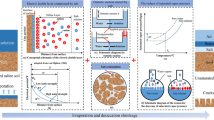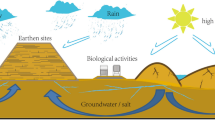Summary
In a field experiment, the pattern and size of shrinkage cracks were studied under three vegetative covers of wheat crop, grass and cultivated fallow. Both the pattern and size of cracking varied widely. Under wheat crop, the major cracks developed parallel to the rows particularly midway between the two rows of plants. The cracks were few in number and simple in nature. And so was the case under grass where the major cracks developed either in between or around the grass tussocks. However, under cultivated fallow development of too many cracks forming an intricate network showed no definite pattern of cracking. In a soil other than the cultivated fallow, the pattern of cracking appeared to be a function of positioning of the plants rather than of the soil itself.
As far as the size of cracks is concerned, the widest and deepest cracks developed under wheat crop and narrowest and shallowest under cultivated fallow. Under grass, the width and depth of the cracks was observed to be intermediate between the two extremes of wheat and cultivated fallow. The size of cracks seemed to depend on the magnitude of water loss from the soil. re]19760713
Similar content being viewed by others
References
Abruna, F. and Smith, R. M., Clay mineral types and related soil properties in Puerto Rico. Soil Sci. 75, 411–420 (1953).
Adams, J. E. and Hanks, R. J., Evaporation from soil shrinkage cracks. Soil Sci. Soc. Am. Proc. 28, 281–289 (1964).
Dugarov, V. I., Frost-caused cracks in soil and their hydrothermal role. Trudy Buryat. Skh. Inst. 18, 34–41 (1965).
Fox, W. E., Cracking characteristics and field capacity in a swelling soil. Soil Sci. 98, 413 (1964).
Goto, S. and Kobayashi, J., The characteristics and prevention of fissures in damp fields. J. Agric. Eng. Soc. Japan 25, 88–93 (1957).
Johnson, J. R. and Hill, H. O., A study of shrinkage and swelling properties of Rendzina soils. Soil Sci. Soc. Am. Proc. 9, 24–29 (1944).
Kaul, B. K., Effect of temperature on the swelling of compressed clays. Cur. Sci. 33, 170–173 (1964).
Smith, R. M., Some structural relationships of Texas blackland soils with special attention to shrinkage and swelling. USDA Agric. Res. Serv.41-28, 51 (1959).
Ward, W. H., Soil movement and weather. Dept. Sci. Industr. Res., Build. Res. Stn. Note No. E383, 9 (1952).
Author information
Authors and Affiliations
Rights and permissions
About this article
Cite this article
Sharma, R.B., Verma, G.P. Characterization of shrinkage cracks in medium black clay soil of madhya pradesh. Plant Soil 48, 323–333 (1977). https://doi.org/10.1007/BF02187244
Received:
Issue Date:
DOI: https://doi.org/10.1007/BF02187244




